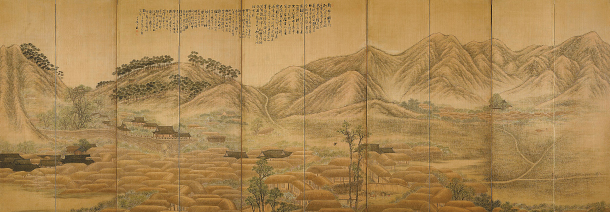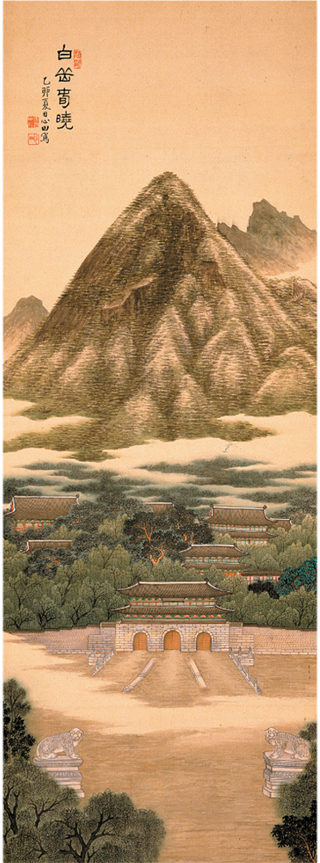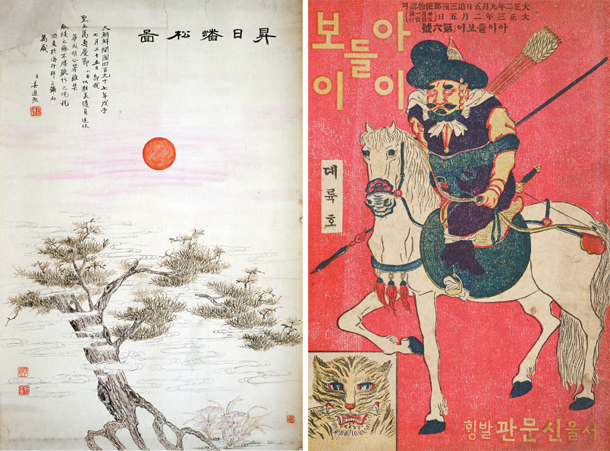Celebrating An Jung-sik’s legacy: The modern master captured a pivotal point in Korean history

An’s “Yeong-gwang Landscape” (1915). [NATIONAL MUSEUM OF KOREA]
“It was a chaotic age when the East and the West, and the old and the new, also coexisted,” Kim said. “Those artists, including An, made an effort to maintain our culture and national identity through their artwork.”

One of master Korean calligrapher and painter Simjeon An Jung-sik (1861-1919)’s “Spring Dawn at Mount Baegak” (1915) painting, depicting summer at Mount Baegak and Gyeongbok Palace in central Seoul. [NATIONAL MUSEUM OF KOREA]
“An did not paint Gyeongbok Palace as it looked during the time,” said Kim, “but used his memory and pictures from the past to bring back the old Gyeongbok Palace before the Japanese changed it into an exhibition hall. Such paintings allow us to witness the spirit of resistance of the artists who worked during this period of transition.”
That is why the National Museum of Korea has organized the “Modern Transitions in Korean Calligraphy and Painting” exhibition at its special exhibition gallery in central Seoul, which kicked off on April 23 and will run through June 2. There are 100 artworks on display specifically picked to commemorate the 100th anniversary of the death of An, says Bae Ki-dong, the director general of the museum.
The exhibition is divided into six sections. It starts off as visitors walk through a “digital time tunnel,” describes Kim, “which takes visitors to 100 years ago using lights, sounds and digital media.”
The first section sheds light on the “New Generation of Korean Calligraphy and Painting.” Although the exhibit focuses on works created by An, Kim says there were many other artists who also worked alongside An as Joseon was going through changes after opening its ports in 1876. These young elites became the leading painters of the Korean art scene. That is why the first painting on display in the first section of the exhibit is not of An but Gang Jin-hui (1851-1919)’s “Rising Sun and Pine Tree” (1888).
The second section, “The Brush of Enlightenment,” includes illustration works An created with Oh Se-chang (1864-1953) for magazines and educational books. This was the time when the press printing was first introduced in Joseon, which attracted modern artists like An. He began to foster students as well, which included Ko Hui-dong (1886-1965) and Yi Do-yeong (1884-1934).
The Korea-Japan Annexation of 1910 forced many government officials, intellectuals and artists to stand at a crossroads. This is when artists like Oh began compiling history of Korean calligraphy and painting while seeking ways for independence, while artists Kim Jin-woo and Lee Hoe-yeong showed their resistance through paintings. Their works can be witnessed in the third “The Art of Resistance and Seclusion” section.

At left is Gang Jin-hui’s (1851-1919) “Rising Sun and Pine Tree” (1888). At right is a book cover illustrated by Simjeon An Jung-sik (1861-1919) in 1913, titled “Aideul Boy.” [NATIONAL MUSEUM OF KOREA]
In the final “Challenges and Seeking of New Ways” section, paintings from after the 1920s are displayed. At the time, artists confronted a different challenge, as painters and calligraphers were seeking changes in accordance with a new era.
“It’s the first time in 39 years that the museum organized a calligraphy and painting exhibition,” Bae said.
BY YIM SEUNG-HYE [sharon@joongang.co.kr]










with the Korea JoongAng Daily
To write comments, please log in to one of the accounts.
Standards Board Policy (0/250자)